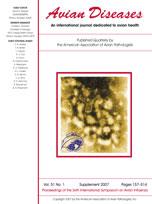In February 2004 a highly pathogenic avian influenza outbreak erupted in the Fraser Valley of British Columbia, Canada. The index farm was a chicken broiler breeder operation comprising two flocks, 24 and 52 wk of age. Birds in the older flock presented with a mild drop in egg production and a small increase in mortality. Pathological specimens taken from the older flock were submitted to the provincial veterinary diagnostic laboratory from which an influenza A virus was isolated. While still under investigation by the provincial veterinary authorities, a spike in mortality was observed in birds belonging to the younger flock. Diagnostic material from both flocks was forwarded to the Canadian Food Inspection Agency's National Centre for Foreign Animal Disease. A low-pathogenicity H7N3 virus was detected in the older flock and a novel highly pathogenic H7N3 virus was found in specimens collected from the younger flock. Despite destruction and disposal of birds on the index farm, the virus spread to adjacent farms. Given the high density of poultry operations in the Fraser Valley and the high level of integration amongst industry support services, a total of approximately 17 million chickens, turkeys, ducks, geese, and speciality birds were put at immediate risk. Despite movement controls the virus spread and established itself in three distinct clusters. To prevent further spread, healthy, marketable birds outside of the surveillance areas were pre-emptively slaughtered. Although highly pathogenic avian influenza is a federal responsibility, the successful control and eradication of this outbreak would not have been possible without the cooperative involvement of federal and provincial diagnostic laboratories. The success of this collaboration was partly responsible for the formation of a national avian influenza laboratory network.
How to translate text using browser tools
1 March 2007
The Roles of National and Provincial Diagnostic Laboratories in the Eradication of Highly Pathogenic H7N3 Avian Influenza Virus from the Fraser Valley of British Columbia, Canada
John Pasick,
John Robinson,
Kathleen Hooper-McGrevy,
Peter Wright,
Paul Kitching,
Katherine Handel,
John Copps,
Deidre Ridd,
Helen Kehler,
Kevin Hills,
Colleen Cottam-Birt
ACCESS THE FULL ARTICLE

Avian Diseases
Vol. 51 • No. s1
March 2007
Vol. 51 • No. s1
March 2007
avian influenza laboratory network
H7N3 highly pathogenic avian influenza
real-time reverse transcriptase polymerase chain reaction




